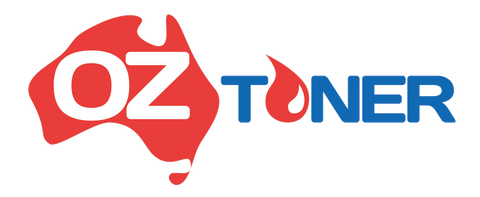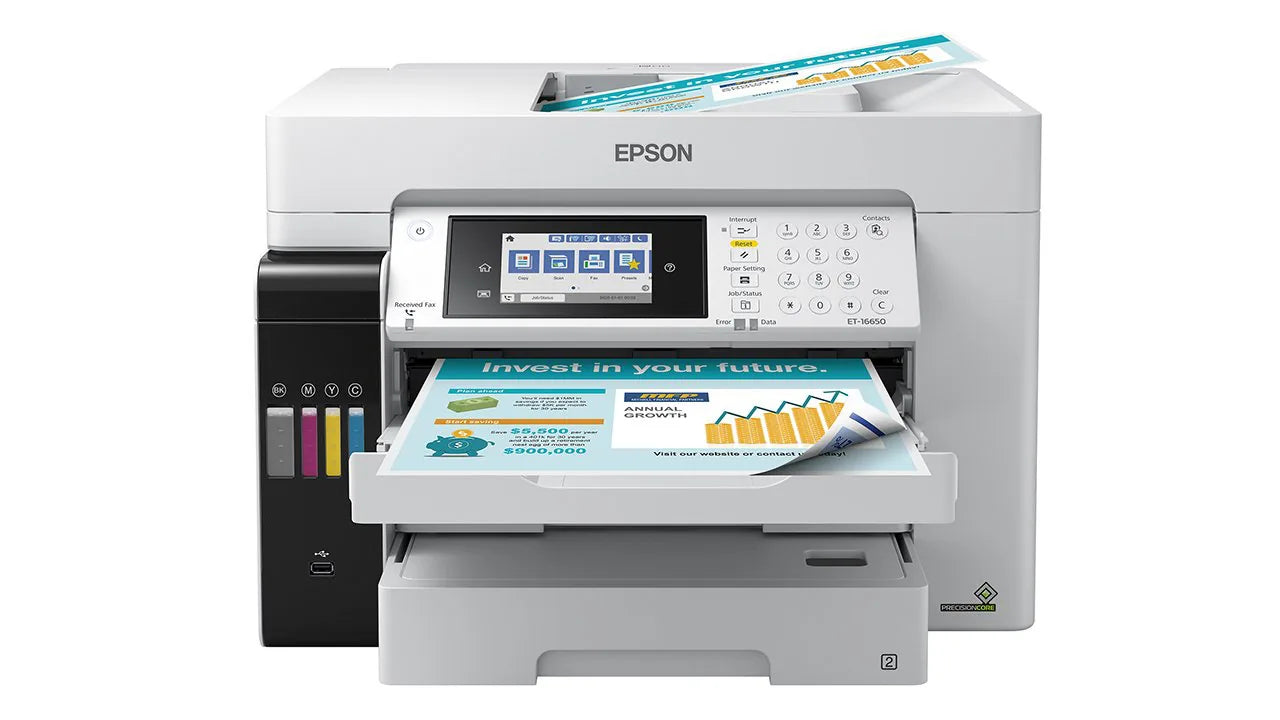Epson EcoTank Pro ET-16650
Into the great wide (format) open: A winning bulk-ink model bursts forth
-
PROS
- Two years of unlimited ink
- Excellent print quality
- Very low running costs
- Auto-duplexing ADF
- Thousands of pages worth of ink in the box
- Two-year warranty with registration
- Excellent mobile connectivity options
-
CONS
- High initial purchase price
EPSON ECOTANK PRO ET-16650 SPECS
| Automatic Document Feeder | |
| Color or Monochrome | 1-pass color |
| Connection Type | Bluetooth |
| Connection Type | Ethernet |
Flagship of the new EcoTank Pro brand of small-business and workgroup inkjet printers, Epson’s EcoTank Pro ET-16650 ($1,129.99) is a feature-rich wide-format all-in-one (AIO) capable of printing pages up to supertabloid size (13 by 19 inches), as well as scanning and copying standard tabloid size (11 by 17 inches). As one of the company’s bulk-ink EcoTank AIOs, it prints color pages at an exceptionally low cost per page. Like the competing wide-format Brother MFC-J6945DW INKvestment and HP PageWide Pro 750dw (Editors’ Choice models both), the ET-16650 prints well and at a reasonable clip. And Epson is throwing in all-you-can-eat ink for the first two years that you own this (or another EcoTank Pro) machine. This incredible value, its relatively high volume and capacity ratings, and its strong feature set are more than enough to earn the ET-16650 our Editors’ Choice nod for a medium-volume wide-format AIO for small to midsize offices and workgroups.
Tight Footprint, Productivity-Packed Feature Set
As mentioned, the ET-16650 is the top-tier model in Epson’s latest EcoTank Pro line of business-oriented machines. The brand currently includes two wide-format AIOs (this one, and the ET-16600), as well as three letter-size machines, all with gradually increasing feature sets and capacities, with pricing from $799 up. We’ll look at them in turn in the coming weeks.
Meanwhile, the ET-16650 measures 13.8 by 20.3 by 19.7 inches (with its trays closed) and weighs about 46.1 pounds, which, among several of its wide-format competitors, is light and compact, especially considering that most of them don’t support the supertabloid page size. Brother’s formidable MFC-J6945DW (prints, scans, copies, and faxes 11-by-17-inch pages), for instance, is slightly taller and longer, and outweighs the Epson by about seven pounds.
And yet another Epson PCMag wide-format favorite, the WorkForce Pro WF-C8690 A3 Color MFP With PCL/PostScript, which also supports supertabloid-size media, sprawls out in all directions by several inches more than today’s EcoTank model. It also weighs more than twice as much.
What makes any printer an all-in-one, of course, is its scanner, and, in this case, that is a 50-sheet auto-duplexing (scans both sides of two-sided pages automatically) automatic document feeder (ADF). It's capable of scanning, copying, and faxing one- and two-sided multipage documents without user intervention.

Of the machines mentioned here so far, both the MFC-J6945DW and WF-C8690 also come with auto-duplexing 50-sheet ADFs. The HP 750dw is, on the other hand, a single-function (print only) device sans a scanner and ADF. (I refer to it here and throughout for comparison only.)
As with most business-oriented AIOs and single-function printers nowadays, you can do plenty from this model's control panel: configure the AIO, monitor consumables, generate usage and other reports, and perform walk-up tasks. Those tasks include making copies, printing from or scanning to the cloud, and setting and monitoring security features. The ET-16650’s control panel is shown below.

This spacious and easy-to-use set of controls consists of a handful of task-specific buttons, such as Job Status and Paper Setting, and a number pad—all anchored by a spacious 4.3-inch color touch screen. You also get, of course (as you do with any business-oriented AIO these days), an onboard web portal that provides access to all operational and configuration tasks from virtually any PC or mobile device web browser.
As mentioned, the ET-16650 prints pages up to 13 by 19 inches, and it copies and scans up to 11 by 17 inches, both one- and two-sided. It can also print borderless pages up to tabloid-size, which I’ll talk about a bit more in a moment.
The ET-16650’s paper capacity is 550 sheets, split between two 250-sheet cassettes up front and a 50-sheet multipurpose tray that pulls up and slightly out from the back of the machine. Brother’s MFC-J6945DW, by comparison, holds up to 600 sheets from three separate sources, and the Epson WF-C8690 supports 330 sheets from two sources, expandable to 1,830 sheets from four sources.

The ET-16650’s maximum monthly duty cycle is 66,000 pages, with a recommended monthly print volume of 3,300 prints. That’s more than half of the Brother's maximum, and its recommended volume is 1,300 pages less, while the WF-C8690’s duty cycle and suggested volumes are 9,000 and 1,700 prints higher, respectively.
Copious Connectivity
Given the ET-16650’s long list of interfaces, I doubt that there are many devices incapable of connecting to it in one way or another, whether desktop, laptop, or handheld. The hardware interfaces are Ethernet (up to 100Mbps), connecting to a single PC via USB, Wi-Fi, Wi-Fi Direct, and Bluetooth BLE (Bluetooth Light Edition). Those last two provide peer-to-peer connections that allow you to connect your smartphones and tablets to the printer without either it or them being part of the same network.
Other mobile connectivity options include Apple AirPrint, Mopria, and a slew of options, such as Email Print, Scan to Cloud, Remote Printer Driver, and several others via Epson Connect. You also get the Epson iPrint Mobile App for printing from and scanning directly to your iOS or Android handheld.
Modest But Adequate Print Speeds
Epson rates the ET-16650 at 25 letter-size (8.5-by-11 inch) pages per minute, or ppm, which is moderate for a midrange AIO. I tested it over Ethernet from our standard Intel Core i5 testbed running Windows 10 Pro. (See how we test printers.) In the first round of tests, entailing printing a 12-page Microsoft Word text document several times and averaging the results, I clocked the ET-16650 at 27.5ppm, or 2.5ppm faster than Epson’s rating. That's 9.2ppm faster than Brother's MFC-J6945DW, 0.8ppm slower than the Epson WF-C8690, and 8ppm behind HP’s 750dw.
For the next round of tests, I timed the ET-16650 as it chewed on our collection of complex, color business documents. These comprise a batch of Adobe Acrobat documents, Microsoft Excel spreadsheets (with accompanying charts and graphs), and PowerPoint handouts made up of somewhat intricate graphics and fonts varying in type, size, and colors.
Then, I combined these results with those from printing the 12-page text document and came up with an average of 17.9ppm. Here, the ET-16650 outdid all but its WorkForce Pro WF-C8690 sibling, which beat it by 0.8ppm, or close enough to be a tie.
Finally, I timed and averaged the ET-16650’s results as it printed our colorful, busy 4-by-6-inch test snapshots. It yielded a score of 11 seconds each, about average among the printers mentioned here (and many others).
PrecisionCore 4S Output
Like the company's WorkForce Pro line of printers, the EcoTank Pro models feature Epson's PrecisionCore 4S printhead, a set of two PrecisionCore Heat-Free ink chips with small, dense, and tightly clustered nozzles that produce terrific detail and color accuracy. True, nearly all inkjet printers churn out respectable-looking output nowadays, but few, especially when closely inspected for graininess and detail, perform quite this well.
The ET-16650's text easily rivals laser output, down to the smallest font we test, 4 points, which is more than acceptable for business document output. In addition, the full-page graphics and handout pages I printed came out with no readily noticeable flaws. I saw no unsightly color shifts, and details including hairlines thinner than 1 point came out unbroken from end to end. It wasn’t until I examined the output up close, looking for specific types of ink distribution flaws, that I found minor instances of banding in a few dark fills and gradients. And I emphasize minor.
Photographs looked good, too, and, unlike the Epson WF-C8690 and HP 750dw, the ET-16650 supports borderless (known in the document design world as "bleeds") photos and documents up to tabloid size, allowing you to use your printer for creating quality, professional-looking marketing material. Many documents (and especially photos) take on an appearance of higher professionalism when bleeds are used creatively. I’ve no complaints about the ET-16650’s output.
Color Output for a Song
Once you buy the printer and run through the first two years' worth of ink, the ET-16650's running costs come out to about 2 cents per page for both monochrome and color pages. The cost per black page is nothing to get excited over; it's about the same as what you'd get from an entry-level or midrange color laser printer. But the 2 cents per color page more than balances out the slightly pricey monochrome running costs. In fact, it should entice you to use color more often.
But Epson is just getting started. Currently, and for a while into the future, the company is offering two years of unlimited free ink with the purchase of an EcoTank Pro machine. That’s right, unlimited. Go ahead, print the suggested volume of 3,300 pages each month. Simply send Epson the receipts—and get reimbursed—every time you buy ink for the first two years that you own the printer.

What your particular per-page cost comes out to under this promotion is impossible for me to calculate, since every business’s volume is different, but, conceivably, you could bring your cost per page down to fractions of a penny per page.
In any case, by comparison, the Brother MFC-J6945DW’s running costs are just under 1 cent for monochrome pages and just under 5 cents for color, while the HP 750dw prints at about 1.1 cents for black pages and 5.6 cents for color. Epson’s WF-C8690’s running costs are 1.6 cents monochrome and 6.7 cents color. Note also that several other EcoTank AIOs, including the Editors' Choice ET-4760, print both monochrome and color pages for under a penny per page.
However, none has near the volume rating, capacity, and feature set of the EcoTank Pro series models. In other words, while they’re cheaper to use, if you need a full-blown, full-featured small-business-oriented AIO, chances are that the smaller, less expensive EcoTank models may not fit the bill as well as the ET-16650 and its EcoTank Pro siblings.
No Tradeoffs Here
One of my consistent complaints about the EcoTank (and other manufacturers’ bulk-ink products, including Brother’s INKvestment, Canon’s MegaTank, and HP’s Smart Tank Plus) is that the features you give up for the lower-cost ink are considerable. With this new EcoTank Pro line, however, Epson has not skimped on features, capacity, or volume, making them much more attractive to small businesses with robust printing, copying, and other document processing needs. There’s little to dislike about the EcoTank Pro ET-16650, rendering it an easy choice as our favorite midrange wide-format AIO.



